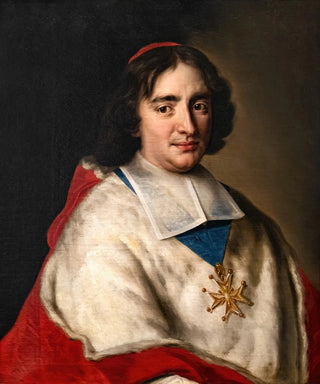Art print | Portrait of Pierre de Bonzi, Cardinal-Archbishop of Narbonne - Jean-François de Troy


View from behind

Frame (optional)
In the vast panorama of art history, some works stand out for their ability to capture not only the physical appearance of an individual but also the very essence of their character and era. The "Portrait of Pierre de Bonzi, cardinal-archbishop of Narbonne" by Jean-François de Troy is a perfect example. This piece, created in the early 18th century, marks a pivotal moment in French art, where the portrait becomes a means of asserting social status and spiritual values of its subjects. The artist, using refined painting techniques, manages to create an atmosphere that is both solemn and intimate, inviting the viewer to contemplate not only the face of the cardinal-bishop but also the weight of his ecclesiastical office.
Style and uniqueness of the work
Jean-François de Troy's style is characterized by a finesse and delicacy that are uniquely his own. In this portrait, he succeeds in marrying meticulous realism with a certain idealization, typical of Baroque portraiture. The color palette chosen evokes depth and richness that enhance the dignity of the subject. The drapery of the cardinal's cassock is rendered with incredible precision, each fold seeming to tell a story. The play of light and shadow, skillfully orchestrated, adds an almost sculptural dimension to the piece, emphasizing the features of Pierre de Bonzi and revealing his wisdom and authority. This painting does not merely depict a man; it embodies an era, an institution, and a whole chapter of France's religious and political history.
The artist and his influence
Jean-François de Troy, an emblematic figure of the French school of painting, established his reputation through his talent and artistic vision. Trained in a context where art was deeply connected to the court and the Church, he skillfully navigated between the various influences of his time, integrating elements of Classicism while foreshadowing the Rococo style. His work left a mark on his contemporaries and continues to inspire generations of artists. By representing figures of the

Matte finish

View from behind

Frame (optional)
In the vast panorama of art history, some works stand out for their ability to capture not only the physical appearance of an individual but also the very essence of their character and era. The "Portrait of Pierre de Bonzi, cardinal-archbishop of Narbonne" by Jean-François de Troy is a perfect example. This piece, created in the early 18th century, marks a pivotal moment in French art, where the portrait becomes a means of asserting social status and spiritual values of its subjects. The artist, using refined painting techniques, manages to create an atmosphere that is both solemn and intimate, inviting the viewer to contemplate not only the face of the cardinal-bishop but also the weight of his ecclesiastical office.
Style and uniqueness of the work
Jean-François de Troy's style is characterized by a finesse and delicacy that are uniquely his own. In this portrait, he succeeds in marrying meticulous realism with a certain idealization, typical of Baroque portraiture. The color palette chosen evokes depth and richness that enhance the dignity of the subject. The drapery of the cardinal's cassock is rendered with incredible precision, each fold seeming to tell a story. The play of light and shadow, skillfully orchestrated, adds an almost sculptural dimension to the piece, emphasizing the features of Pierre de Bonzi and revealing his wisdom and authority. This painting does not merely depict a man; it embodies an era, an institution, and a whole chapter of France's religious and political history.
The artist and his influence
Jean-François de Troy, an emblematic figure of the French school of painting, established his reputation through his talent and artistic vision. Trained in a context where art was deeply connected to the court and the Church, he skillfully navigated between the various influences of his time, integrating elements of Classicism while foreshadowing the Rococo style. His work left a mark on his contemporaries and continues to inspire generations of artists. By representing figures of the






